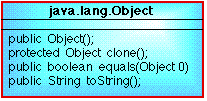2. EQUALS EXAMPLE
In Table 1 a short class is presented comprising a single field
(numX), a constructor and a method which adds its argument to
nummX. Note that the class explicitly extends the class
object, althoufgh this would be infered (by default) by the Java
compiler.
In Table 2 an application calls is presented which makes use of
this class. The application creates an instance of the class ClassOne,
copies the object reference variable to a second reference variable
object2 and compares the two objects using the equals method
in the Object class. A third instance of the class ClassOne is
then created, with the same value, and this is then compared to the original
object1 instance; agian using the equals method
in the Object class.
|
// Example Class - ClassOne
// Frans Coenen
// 10 March 2000
// Dept Computer Science, University of Liverpool
class ClassOne extends Object{
private int numX;
// ---------- CONSTRCUTORS ----------
public ClassOne(int value) {
numX = value;
}
// ----------- METHODS ----------
/* Function 1 */
public void function1(int numY) {
numX = numX+numY;
}
}
|
Table 1: An example class
|
